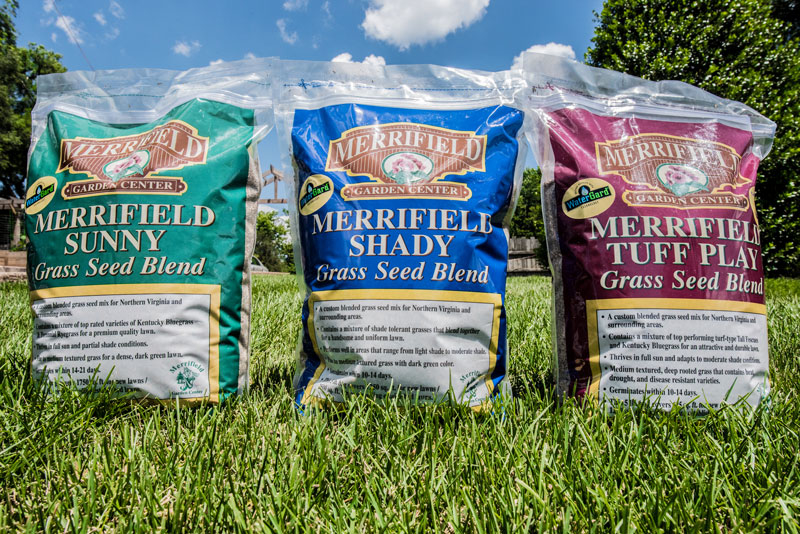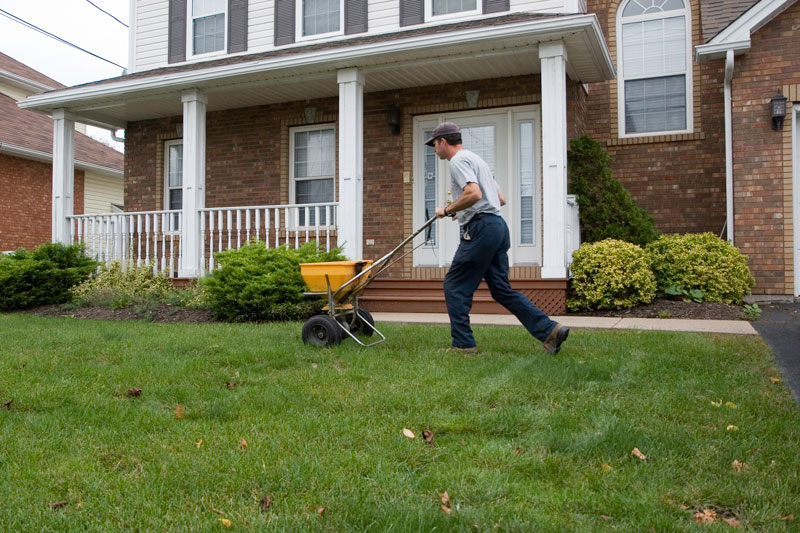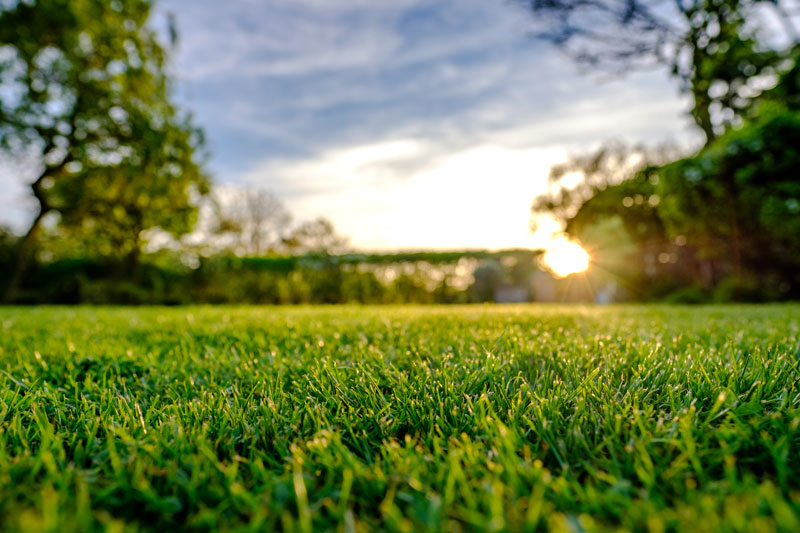5 Steps to Restore Your Lawn this Fall
In this video, Plant and Turf Specialist David Yost outlines 5 steps you can take to restore your lawn to a lush, healthy state in the fall following the stressful conditions of summer.
In this video, Plant and Turf Specialist David Yost outlines 5 steps you can take to restore your lawn to a lush, healthy state in the fall following the stressful conditions of summer.
This post was originally published in August 2017.
The summer places some serious strain on our lawns. High temperatures, weeds, and drought conditions can all cause our turf to suffer, losing density, color and health. The end of summer is a great time to start thinking about giving your lawn some restorative care to bring back the green and help it regain density and color. To begin, evaluate your lawn and think about what you would like to accomplish. Do you need to overseed, eliminate weeds, or simply fertilize your lawn? Each of these tasks can be completed in just a few, simple steps as long as we are mindful of the correct time and order in which to begin each process.

Does your lawn have bare patches, or do you want to introduce new grass varieties to your existing lawn? If so, September is the ideal time to seed, . Seeding now will give you plenty of time to complete several rounds of fertilization before winter sets in. Before you begin seeding, scrape up bare spots in your lawn and loosen the soil to create good contact between your soil and the grass seed you will be spreading. This is also a great time to mix in some compost if you want to improve your soil. Then, select your grass seed and spread it over the lawn using a drop or rotary spreader. We recommend one of our three Merrifield seed blends, which have been custom-designed to perform well in our local environment.

Regardless of whether or not you plan to seed, September is the ideal time to begin your fall lawn fertilization project. We recommend fertilizing every 4-6 weeks, with 2-3 applications before winter. If you are seeding your lawn, fertilize immediately after seeding with Merrifield Select seed starting lawn food for your first application, then follow up every 4-6 weeks with Merrifield Premium Lawn Food. If you are not seeding your lawn, use Merrifield Premium for all fertilizer applications.

If weeds are overtaking your lawn, you can focus on killing summer weeds and preventing winter weeds in September. Bayer Advanced Season Long Weed Control will simultaneously kill existing weeds, such as clover and dandelions, while preventing weeds, such as chickweed, bittercress and others from taking over next spring. If you just want to prevent winter weeds, use Fertilome Broadleaf Weed Control with Gallery. You cannot use either of these products if you plan to seed your lawn immediately, as they will prevent your seed from germinating. If you wish to seed your lawn and prevent winter weeds at the same time, you will need to use Scotts Step 1 for Seeding with Weed Preventer. If you wish to seed your lawn and eliminate summer weeds, you will need to apply Trimec Lawn Weed Killer immediately and then wait for the time specified on the product label before you begin your seeding project. Generally, you will need to wait 2-3 weeks. Be sure to carefully follow the instructions on the weed control label to ensure your seed is not damaged.
Every lawn is different! If you have questions about the steps you should take to bring out the best in your lawn, we encourage you to come in to visit our turf specialists.
David Yost, Merrifield Plant Specialist
We spent the summer months combating hot, dry weather and annual weeds that left our lawns thin and patched. Now it is the perfect time to focus on repairing the damage with a combination of overseeding and fertilizing to restore our lawns to a thick carpet of green.
As the fall season approaches, the weather creates optimal growing conditions for cool season grasses. The shorter days and slightly cooler temperature stimulates growth, and more frequent rain helps prevent the seeds from drying out in the heat. But still the soil is warm enough to help the seeds germinate and establish root systems before winter. In our area, prime seeding time is generally from September 1 through October 15 for cool-season grasses.
The good news is that seeding is simple and you make a dramatic improvement to your landscape in a short period of time! It just takes preparation, the right mix of seed and fertilizer, and water to keep your soil moist to the touch.
When you paint a room in your house, it takes longer to prepare the room than it does to actually paint. The same is true with seeding! The more effort you put into preparing your grass, the better your results will be.
To begin, mow your lawn shorter than usual to about a two-inch cutting height. Then it’s time to rake your soil, remove old debris and dead grass and dethatch, if necessary. At a minimum this can be achieved through vigorous raking. If you have a larger space or access to an aerator, we recommend core aerating the surface to cultivate the ground and open up the turf canopy to increase your soil to seed contact.
At Merrifield we’ve developed three custom grass seed blends. We’ve mixed them specifically to include varieties that are superior performers in local and regional turf trials conducted independently by Virginia Tech and the University of Maryland. These varieties have been evaluated locally for our conditions and blended for three different environments:
This is our most versatile and popular mixture and contains tall fescues with a touch of Kentucky bluegrass. This mix performs well in conditions with at least four hours of sun to full sun. It establishes itself quickly, tolerates drought, wear and tear, and disease problems for a beautiful, low-maintenance lawn.
This blend contains fine-textured fescues and is ideal for use in moderate to heavy shade conditions. This mix performs well in dry, shady conditions where trees may compete for sun, water and nutrients.
This blend consists of top performing Kentucky bluegrass and perennial ryegrass, which provide a premium quality lawn with a rich, dark green color. The finer-bladed grasses in this blend perform well in full sun to part shade conditions but do require more maintenance and water than fescue blends.
Our plant specialists can help you find the appropriate grass seed and amount for your lawn based on your conditions and the square footage of your yard.
Disperse your grass seed uniformly over the soil, either by hand or by using a handheld or push spreader. Turn over a rake and use the back of the tines to gently work the seed into the soil. Be sure to keep your strokes light to avoid redistributing the seed.
Once you’ve dispersed your seed evenly, add a starter fertilizer to promote seed germination. We recommend our Merrifield Select 14-18-14 as it’s high phosphorous level promotes strong root development. It’s also slow release so it won’t burn the new seedlings.
Top dress your seed and fertilizer with a thin layer of compost. As the compost breaks down, it helps improve the soil structure and keeps the seed moist and protected to promote germination.
When watering seed, our objective is to keep the surface of the soil moist to the touch. This is different from watering an established lawn where we aim to water deeply to develop an established root system. A general guide is to water your new seeds for 10-minutes every day the first week, 10-minutes every-other-day the second week, and 10-minutes every third day the third week. Check the soil daily and adjust your watering schedule according to the weather.
If you prepare and water properly, you can see sprouting with Merrifield Tuff Play within one week and be at mowing time within four weeks!
Four to six weeks after your initial application, fertilize your lawn with Merrifield Premium 26-0-12. This fertilizer contains sulfate of potash for drought resistance and turf vigor and long lasting, slow release nitrogen for a thick, healthy lawn. Reapply Merrifield Premium a second time, four to six weeks after the first application. After each application, water within a day to activate the fertilizer.
With any landscape project, exposing your soil can promote weed growth as weeds live within your soil. If you see weed growth following your restoration project, please bring your lawn samples into our Plant Clinic. Our plant specialists can recommend a treatment for your unique lawn conditions.
David Yost, Merrifield Plant Specialist
In our area, our lawns are the happiest when the temperature is between 50 and 75 degrees F and they get about an inch of water per week. With the soaring temperatures and lack of rain we encountered in July and August, our lawns are way out of their comfort zone! Stressed, thin lawns become vulnerable to weed takeover.
The last few weeks we’ve seen lawns mostly struggling with summer annual grassy and broadleaf weeds. these include crabgrass, Japanese stiltgrass, spurge and lespedeza. This a good time to treat these weeds and get ready to restore your lawn as the ideal time for seeding is right around the corner.
If you’re struggling with grassy weeds, such as crabgrass and Japanese stiltgrass, we recommend Bayer Advanced Bermudagrass Control for Lawns. If you’re struggling with broadleaf grasses, such as spurge or lespedeza and/or grassy weeds, we recommend Trimec Crabgrass Plus Lawn Weed Killer. You can apply either product immediately. Just be sure to wait three to four weeks before seeding your lawn.
If you’re not sure what weed has taken over your lawn, bring a sample into any of our three stores and see a plant specialist at our plant clinic. We’re more than happy to help you diagnose the problem and recommend a treatment plan.
Summer annual weeds can be prevented, but the treatment must take place in the spring. The best way to protect your lawn from summer weed takeover is by maintaining a thick, dense turf.

